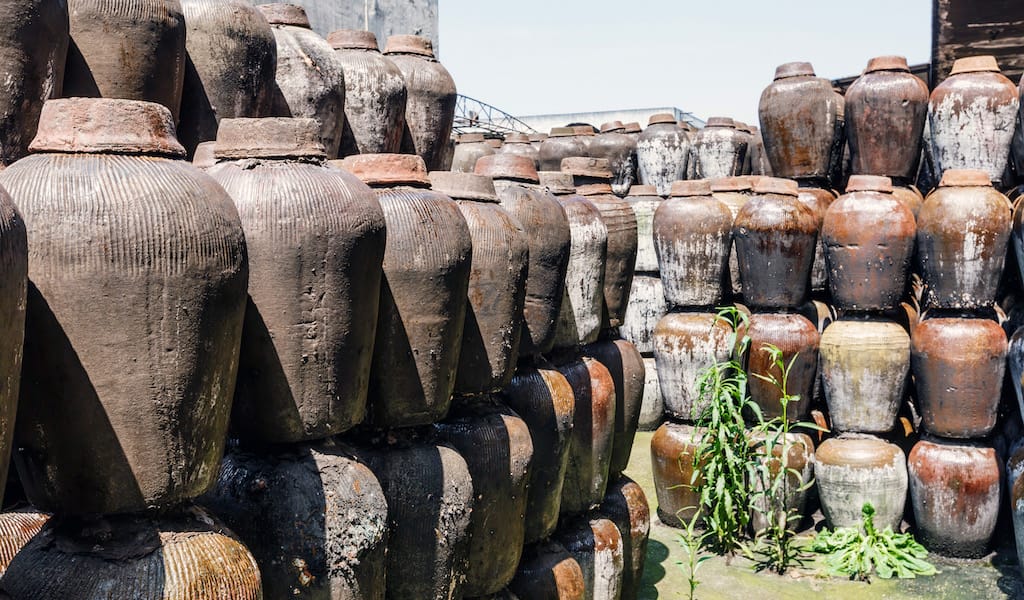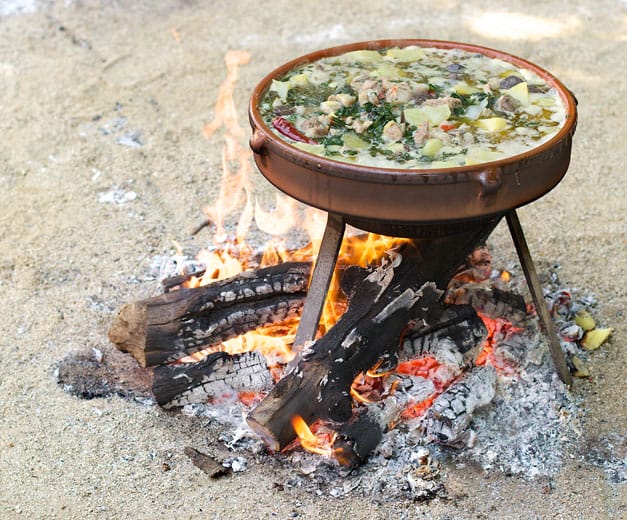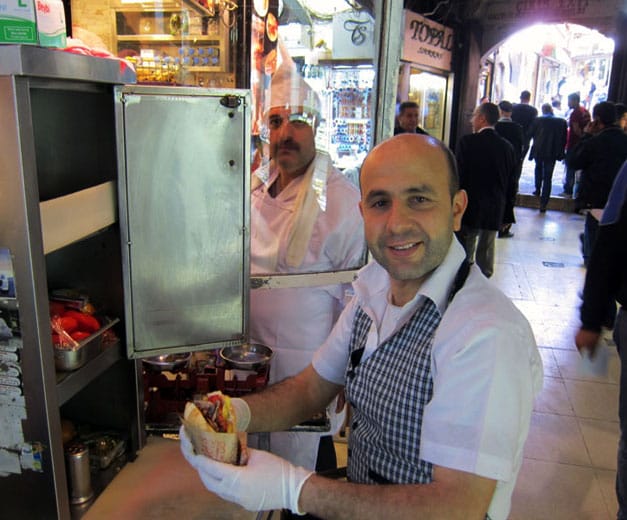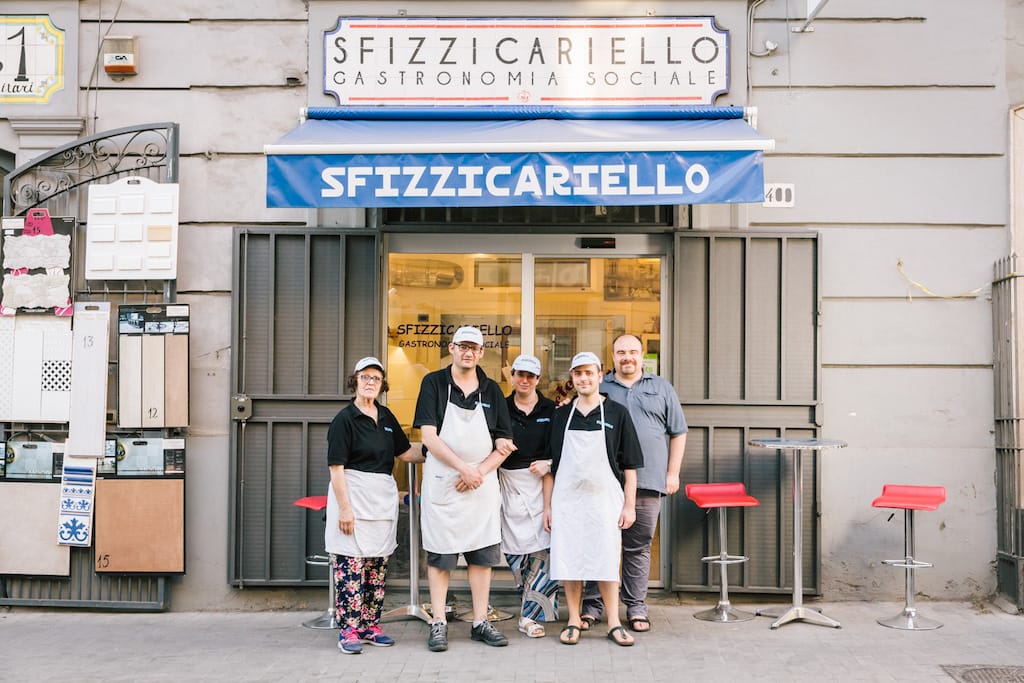Legend has it that huangjiu, or yellow wine, was invented by Du Kang, the god of Chinese alcohol. Annual production starts in eastern China’s Shaoxing region in the tenth lunar month – the temperature and humidity at that time of year create the best environment for making the wine – with sacrifices to Du Kang.
The wine is made from fermenting glutinous rice with wheat or rice qu, a cake of mashed grains that cultivate yeast; both convert the starch to sugar then to alcohol. The product of all that fermentation is a sherry-like amber liquid that is used in Chinese cooking or served as a drink paired with Chinese foods.
The most famous variety hails from Shaoxing in Zhejiang province, originally due to the pure water of Mirror Lake that was used to make the huangjiu. The Traditional Chinese Medicine (TCM) benefits of the drink are legion, and include “invigorating the blood.” TCM practitioners recommend pairing Shaoxing huangjiu, considered a “warming” drink, with “cooling” foods like hairy crab or cold chicken to keep your qi in balance.
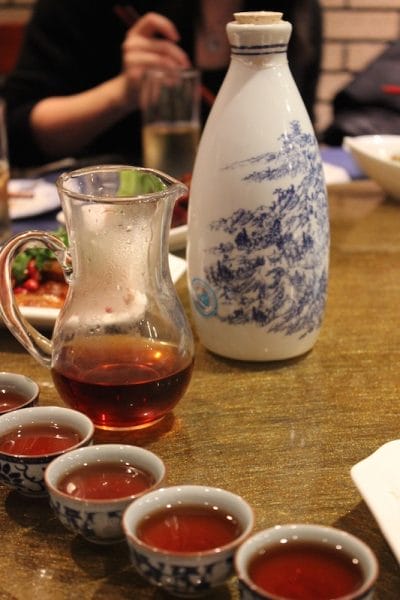 Selecting huangjiu means picking your desired level of sweetness. The drink tops out at around 20 percent alcohol, since it is fermented, not distilled, and the most common varieties are yuanhong, jiafan and shanniang, ordered from least amount of sugar to most.
Selecting huangjiu means picking your desired level of sweetness. The drink tops out at around 20 percent alcohol, since it is fermented, not distilled, and the most common varieties are yuanhong, jiafan and shanniang, ordered from least amount of sugar to most.
Yuanhong – or “Champion’s Red” – is named for the earthenware jars that the wine is aged in. Traditionally in Shaoxing, new parents will buy a jar of this huangjiu and bury it when their child is born, to be dug up to celebrate achievements in the child’s life, like getting married or graduating from school.
With only 15 grams of sugar or less per liter, yuanhong is the basic block upon which all the other varieties of huangjiu are built. Jiafan translates as “add rice,” and that’s exactly what happens when brewers add more glutinous grains in the secondary fermentation to encourage more sugar in this slightly sweeter version. Semi-sweet shanniang uses already-fermented yuanhong in place of water to start its brewing process.
The longer huangjiu ages, the better.
Huadiao is another famous type of huangjiu from Shaoxing, named not for the medium-sweet wine inside, but for the elaborate patterns carved into the jars in which it is aged. When huangjiu is young, the flavor is strong and sweet, so most bottles designed for drinking are aged for at least a year before heading to market – the longer it ages, the better.
Dishes that contain Shaoxing huangjiu are easy to find in the Shanghai region, thanks to its proximity to the city (it’s less than an hour and a half away by bullet train). Plus Shanghainese food shares many characteristics with Zhe cuisine. Check out some of our favorite places to drink huangjiu and eat dishes made with it.
Kong Yi Ji
This Shaoxing restaurant near Confucius Temple specializes in its home city’s huangjiu. The décor is made up of old huangjiu jars and every month, they host a kaitan or “jar opening” where they crack into a giant jug of vintage huangjiu and give patrons a sip on the house. If you’re not in town for the monthly event, you can still order a huangjiu tasting of five different varieties, ranging from 5 to 30 years and varying in degrees of sweetness. Since the menu is from Shaoxing, every dish featuring hairy crab roe (蟹粉xièfěn) is cooked with Shaoxing wine.
Dian Shi Zhai
This classic Shanghinese restaurant serves up drunken chicken (醉鸡 zuì jī) made only with Shaoxing huangjiu. A cold appetizer, drunken chicken is poached with ginger and green onions, then marinated overnight in a bath of huangjiu. The chicken is cut on the bone and served swimming in a light broth of the liquor and it’s cooking liquid. Dongpo pork (东坡肉 Dōng Pō ròu), a dish made famous by Chairman Mao who called it “brain food” and credited it with helping him outsmart his enemies, stews thick squares of fatty pork belly in Shaoxing wine.
Old Jesse
This locally famous Shanghainese restaurant serves up several “drunken” dishes, all of which feature huangjiu as a main ingredient. Drunken crab (醉蟹 zuì xiè) is marinated overnight in the liquor. Since the crab needs to be very fresh for this to be safe – it’s like eating sushi – you need to get it at the best possible place, and Old Jesse is that spot. If you’re not into eating raw, try their oil-exploded shrimp (油爆虾 yóu bào xiā) or an appetizer of wheat gluten (四喜烤麸 sì xǐ kǎo fū), both of which feature huangjiu in their sauces.
Editor’s note: Our recurring Building Blocks feature focuses on foods and ingredients that are fundamental to the cuisines we write about.
This article was originally published on November 16, 2017.
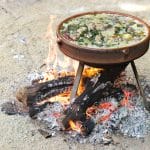 July 7, 2015 CB on the Road
July 7, 2015 CB on the Road
Upon the hot and dry plains of Les Garrigues, two irrigation canals cut through an […] Posted in Barcelona October 17, 2013 Gülebru Kantin
October 17, 2013 Gülebru Kantin
We generally regard the Grand Bazaar as a place of punishment, a den of aggressive, […] Posted in Istanbul July 5, 2019 Sfizzicariello
July 5, 2019 Sfizzicariello
If a gastronomia or delicatessen prepares good food, it can survive for decades. But if […] Posted in Naples
Published on November 01, 2019
Related stories
July 7, 2015
BarcelonaUpon the hot and dry plains of Les Garrigues, two irrigation canals cut through an agricultural expanse, diverging first from the ample Segre River, which runs through the center of the city of Lleida, before subdividing again, their meandering channels reaching farther and farther into an otherwise parched plateau. These life-giving tributaries are collectively known…
October 17, 2013
IstanbulWe generally regard the Grand Bazaar as a place of punishment, a den of aggressive, wolf-like hustlers and innocent, lamb-like tourists wearing novelty fez hats. When we have to go, we like to think of ourselves as members of a prison SWAT team, sent in to search a cell for some specific item – Turkmen…
July 5, 2019
NaplesIf a gastronomia or delicatessen prepares good food, it can survive for decades. But if a gastronomia also promotes a social cause, there is a risk that clients will visit once to silence their consciences, and not return. At Sfizzicariello, a “social gastronomia,” the food is at once excellent, and the cause worthy. A group…







































